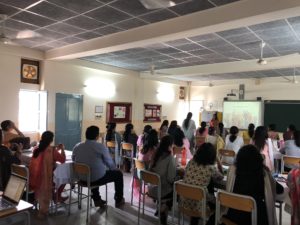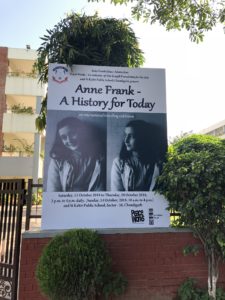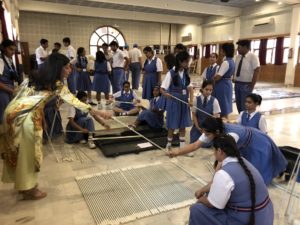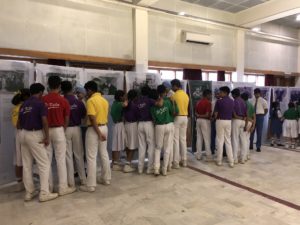Report prepared by Deeptha Vivekanand.
The Anne Frank Project was launched in Chandigarh on 11th October, 2018, at St. Kabir Public School. The project involved the display of the international traveling exhibition ‘Anne Frank – A History for Today’, the screening of the documentary A Short Life of Anne Frank and related educational activities such as peer guide training and a teachers’ workshop on ‘Learning To Live With Difference’.
Implemented activities
Prior to the formal launch of the project, and under the guidance of Ms. G. Chadha, the Chief Education Advisor of St. Kabir School, the History, English and Art teachers, students from Grades 8 to 12, were engaged in various classroom activities involving the diary of Anne Frank, the Holocaust and Human Rights. They created artworks, poetry and other literary pieces that contained their thoughts and opinions about the topics. These were then displayed on specially created panels in the school library.
The peer guide training was conducted on 11th October. 32 students from classes 8, 10 and 11 from St. Kabir School were selected to participate in the training workshop and were trained as exhibition guides by Megha Malhotra of Peaceworks. The topics covered were the history of Anne Frank and the Holocaust and its contemporary relevance. Through the course of the week, students were stationed at the exhibition panels in shifts. They did a commendable job of guiding the visitors to the exhibition. At the end of the program, they were awarded certificates by PeaceWorks.
Teachers’ workshop
 A total of 30 teachers of History and English from 8 schools participated in the one-day teacher workshop on ‘Learning To Live With Difference’, developed by PeaceWorks. In this workshop delivered by Megha, innovative ideas for teaching the story of Anne Frank, the Holocaust and Human Rights were presented. Teachers were also encouraged to explore aspects such as identity, prejudice, and discrimination. All teachers agreed that the story is valuable for their work in schools today, as they see many similarities in the story of Anne Frank and their own history.
A total of 30 teachers of History and English from 8 schools participated in the one-day teacher workshop on ‘Learning To Live With Difference’, developed by PeaceWorks. In this workshop delivered by Megha, innovative ideas for teaching the story of Anne Frank, the Holocaust and Human Rights were presented. Teachers were also encouraged to explore aspects such as identity, prejudice, and discrimination. All teachers agreed that the story is valuable for their work in schools today, as they see many similarities in the story of Anne Frank and their own history.
Inauguration of the ‘Anne Frank – A History for Today’ exhibition
The exhibition was inaugurated on October 12th, 2018 at the St. Kabir School auditorium. The ceremony, hosted by exhibition coordinator Deeptha Vivekanand, began with the lighting of the lamp, followed by a sanskrit song performed by students from Class 6 and 7 of St. Kabir School.
ccccPresent at the inauguration ceremony were Mr. Daljit Ami, filmmaker, and Mr. Vivek Atray, ex-IAS, author and motivational speaker. The management, staff and students of the school formed part of the audience. Principal of the school, Lt. Col. Rattanbir Singh greeted the gathering, stressing on the importance of welcoming such initiatives in Chandigarh. In all, the inauguration was attended by about 40 people. Col. Singh emphasized that young students must engage actively with issues of discrimination and human rights violations through narratives such as Anne Frank’s Diary, which incidentally forms a part of the CBSE curriculum for tenth standard.
ccccDaljit Ami in his keynote address, stressed upon the need to read Anne Frank’s diary from an Indian and Asian perspective. He highlighted human rights violations that were committed during the Partition, and more recently, the Rohingya crisis. Vivek Atray, in his special address spoke about why students must write more deliberately, putting pen to paper in this digital age. He impressed upon them the need to write from a place of joy and anger so that their expressions sound impassioned. This was followed by a class 10 student, Varnika Sharma’s reading out an excerpt from Anne Frank: The Diary Of A Young Girl. The inauguration also included a screening of Gerrit Netten’s documentary, The Short Life of Anne Frank.
Visitors to the Exhibition
On 13th October, the exhibition was thrown open to school students and the general public. Schools in the Tricity were invited to send students between grades 8 and 12 to view the exhibition and the documentary. As an innovative step, St. Kabir School set up an online booking system on its website, to enable schools to book their viewing slots. This made the entire process seamless and easy. Over the course of the week, 9 schools from Chandigarh and Mohali sent their students to attend the exhibition, with a total of 952 students attending.
ccccAround 50 members of the general public, including artists, retired army personnel, filmmakers, educators and parents also walked in to attend the exhibition and film screening, taking the total number of visitors up to 1002. At the end of the exhibition, visitors were encouraged to leave a message on a paper leaf that was then to be tied to a dried branch, evocative of the chestnut tree outside Anne Frank’s attic window.
Conclusion and Recommendations
-
- The school students and teachers who visited the exhibition were deeply moved by the experience and appreciative of the peer guides’ efforts in explaining the panels in great detail. They said that they understood Anne’s story and the effects of the Holocaust much more vividly after reading the panels and watching the film.
- Many visitors to the exhibition (students, teachers and the general public) connected Anne Frank’s story to events happening in the world today. They saw many similarities between the histories of Germany and India, particularly with reference to the Partition. They also expressed that this project could serve as an example and as a way to remember their own stories.
- Both the peer guide training and the teacher seminar were very well received by the participants, inspiring them to think about a way of visualizing their own history. The participants enjoyed the pedagogical methods employed during the teacher seminar and peer guide trainings as well as the interactive nature of activity-based learning, with teachers expressing the desire to employ such methods in their own classrooms. They were also very positive about the collective enrichment of factual knowledge related to WWII this initiative helped generate.
- Media coverage was organised by St. Kabir School. Two newspapers,The Indian Express and The Tribune carried reports. Of the general public who visited the exhibition, only a few people said that they were informed about the project via the media. The rest of them had received messages through their peer groups on Whatsapp and Facebook.
- On the whole, it was a deeply engaging experience for everyone involved. The management, staff and students of St. Kabir School showed tremendous enthusiasm and dedication in ensuring the exhibition and associated activities were carried out smoothly.
- Based on reactions, it is possible to conclude that the Anne Frank exhibition (and its related educational activities) creates a good opportunity for educators to tackle issues of their own history and human rights through their work.
- It is recommended that teachers from schools in and around Chandigarh who participated in the workshop, carry out related educational activities with their students, as outlined in the ‘Learning To Live With Difference’ module. Ideally, it should be taken up as a year long project that inspires students to become Human Rights Defenders within their communities.





